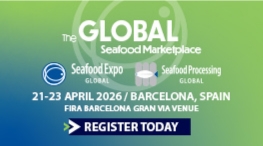This article was featured in Eurofish Magazine 5 2025.
Predators and invasive species are a threat to fisheries and aquaculture across Europe, but also a potential resource. At a conference in Tallinn both aspects were explored in a series of presentations that covered the Baltic, Mediterranean, Black and North Seas as well as the earthen ponds used for the cultivation of freshwater species in many European countries.
Organised by Eurofish International Organisation in cooperation with the Estonian Ministry of Regional Affairs and Agriculture, the international conference Predators and invasive species – a threat or a business opportunity on 17 and 18 June 2025 in Tallinn brought together over 140 participants and 17 speakers from 20 countries. Among the attendees were delegations from ministries, researchers, industry experts, commercial and recreational fishers, as well as representatives from aquaculture and fisheries associations. The event was opened by Hendrik Johannes Terras, Minister of Regional Affairs and Agriculture of Estonia.
Human and environmental factors contribute to presence of invasive species
Following the minister’s welcome, Marco Frederiksen, Director of Eurofish, expressed his gratitude to the ministry for hosting the event and to the audience for their strong interest and participation. After opening remarks highlighting the current state of Estonian fisheries and aquaculture, conference moderators Søren E. Schrøder and Ixai Salvo, both from Eurofish, took over. In the first session speakers focused on the overview of threats in different sea basins of Europe. Markus Vetemaa (Estonian -Marine Institute, University of Tartu) introduced the audience to threats in the Baltic Sea and surrounding inland waters. He implicated heavy maritime traffic, brackish water environment, limited native biodiversity, and climate change in the presence of over 100 new species in the Baltic Sea since the 20th century. Mr Vetamaa emphasised that the cormorant is the most important invasive newcomer in Estonia from the fishery point of view.
The session continued with Matteo Leonardi and Andrea Fabris (Italian Fish Farmers Association) who both talked about invasive species in the Mediterranean Sea and surrounding inland waters. Spotted pufferfish (Lagocephalus sceleratus), scorpion fish (Pterois miles), dusky rabbitfish (Siganus luridus), striped rabbitfish (Siganus argenteus), blue spotted cornetfish (Fistularia commersonii) and blue crab (Callinectes sapidus) are just some of the new species in the sea basin. The audience also learned about benefits and risks in aquaculture production of alien species in the Mediterranean aquaculture. Pieter Boets (Provincial Centre for Environmental Research, Belgium) covered the most recent findings from the North Sea basin area, while Mehmet Aydin (Ordu University, Türkiye) closed the session with challenges and prospect in the Black Sea and adjacent inland waters.
Cormorants as food for human consumption
The second session addressed the commercial opportunities offered by predators and invasive species in salt-water areas and featured seven experts from Estonia, Greece, Denmark, Lithuania and Norway. Annette Kägu and Rain Kuldjärv from the research organisation (TFTAK, Estonia) talked about potential developments on round goby fisheries for human consumption and pet food. Describing the potential of using cormorants to create tasty dishes Urpo Reinthal (YliCool Catering) inspired the audience with different recipes he is developing to support the consumption of cormorants and thereby decrease the burden on the Estonian aquaculture sector.
The draft EU plan to manage cormorant predation was examined by Niels Thorvald Jepsen (DTU Aqua, Denmark), while Papadaki Prinsus (IKE, Greece) showed some of the results from the EU HORIZON project VALIAS that aims to convert marine invasive species into sustainable aquafeed. The status of round goby and its market development in Lithuania was presented by Loreta Bražinskaitė (Ministry of Agriculture, Lithuania). Market dynamics, consumer acceptance, and business opportunities for selected products – including Pacific oysters, sea squirts, and clinging jellyfish – along with recommendations for stakeholders, were the key takeaways from the intervention on markets for products from invasive species by Christian Philip Unmack (Eurofish International Organisation). The first day’s programme concluded with a presentation by Tina Thesslund (NOFIMA, Norway), on the evolution of the invasive king crab into a multi-million-dollar industry in Norway.
Markets for blue crab can be developed
The second day of the conference was opened by Preben Møller from Greenland (Great Greenland A/S), who showed the sustainable hunting, utilisation, and trade of ringed seals and harp seals. Out of a total population of approximately 12 million, around 150,000 seals are hunted annually in Greenland. Sealskin has traditionally been used for housing, bedding, clothing, and other fashion items. Francesca Barazzetta (Eurofish International Organisation) shared her research findings on the utilisation of market opportunities for the American blue crab (Callinectes sapidus) and the blue swimming crab (Portunus segnis), both invasive species in the Mediterranean Sea. Five case studies on blue crab use in markets in Italy, Spain, Turkey, Tunisia, and Greece supported her intervention. Mie Thorborg Pedersen (University of Southern Denmark) showed how jellyfish can contribute to diversifying sustainable food sources, however, limited supply and infrastructure remain key barriers in Europe, as harvesting and processing are not yet well developed.
The third and final session focused on business opportunities related to predators and invasive species in freshwater areas. Béla Halasi-Kovács (Federation of European Aquaculture -Producers) discussed the implications of the draft EU Cormorant Management Plan from the perspective of aquaculture producers. Per Pettersson (Swedish Inland Fishermen’s Federation) spoke about the utilisation of signal crayfish (Pacifastacus leniusculus), while Béla Urbányi (Institute of Agricultural -Economics, Hungary) gave the final presentation on Chinese carps in Hungary.
The second day offered all participants the opportunity to gain first-hand experience during a field trip organised in cooperation with the Fisheries Information Centre of Estonia. At Hara Harbour, delegates had the chance to meet a local fisherman and learn how round goby and cormorants are being utilised in sustainable ways.
Toni Bartulin, Eurofish,
toni@eurofish.dk









